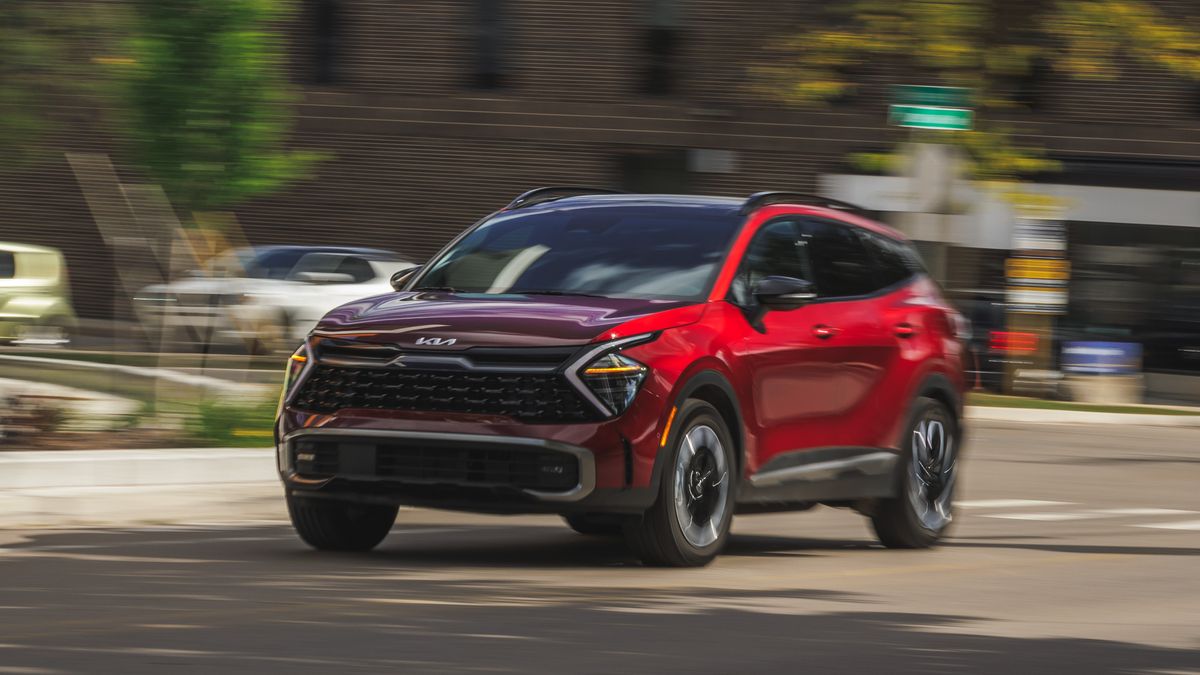Tested: 2023 Kia Sportage PHEV Pairs Comfy Cabin and Zippy Performance

The 2023 Kia Sportage represents a striking and unusual new design direction for Kia’s compact SUV, with the crossover looking like it was penned by aliens and telepathically implanted in Kia’s designers’ brains. Besides the polarizing styling, the fifth-generation Sportage also marks a big shift by offering hybrid powertrains for the first time in the crossover’s history. A 226-hp hybrid effectively replaces the previous car’s optional turbo four-cylinder, while an all-new plug-in hybrid sits atop the lineup with a combined 261 horsepower, making it the most powerful Sportage yet. The plug-in-hybrid powertrain puts some extra pep in the Sportage’s step—especially versus the gutless base motor we drove earlier this year—and while the added power doesn’t transform the crossover into an engaging driver’s car, it makes the Sportage a more agreeable commuter and saves gas in the process.
Our X-Line Prestige test car is the pricier of the two available trim levels and carries a $4500 upcharge over the base X-Line. For that extra dough, the Prestige brings additional driver aids in the form of adaptive cruise control, Highway Driving Assist, Remote Smart Parking Assist, and blind-spot monitoring. Outside, the Prestige gets upgraded headlights and taillights, and LED fog lights. The interior is decked out with multicolor ambient lighting, a Harman Kardon sound system, a power-adjustable front passenger seat, memory for the power driver’s seat, ventilated front seats, a heated steering wheel, a heated windshield, and a 12.3-inch digital gauge cluster. Our $44,680 test car’s only option was the snazzy Dawning Red paint ($395).
The Sportage PHEV utilizes the same system as the plug-in versions of the Sorento and the Hyundai Tucson. It produces 261 horsepower and 258 pound-feet of torque courtesy of a turbocharged 1.6-liter inline-four paired with an electric motor. A 13.8-kWh battery feeds that electric motor, and the PHEV is all-wheel drive only. The electric assistance gives the Sportage the gusto that the base car desperately needs, dashing away from a stop and squirting forward when you need to be decisive in busy traffic. We measured a 6.9-second run to 60 mph. That’s 1.5 seconds behind the plug-in Toyota RAV4 Prime, which has a 41-hp advantage, but at 30 mph the Kia is only 0.3 second adrift.
Despite the Sportage PHEV’s fleet-footedness, it doesn’t encourage spirited driving. The steering is not especially communicative, while the brake pedal feel is inconsistent and was squishy during hard emergency stops. That said, the Sportage far outperformed the RAV4 Prime in our panic braking test, coming to a halt from 70 mph in 167 feet versus the Toyota’s 195-foot stop. There is a fair amount of body roll, but the ride is forgiving, and the Sportage handles well enough for daily driving, even if it can become a bit nervous and unsettled over midcorner bumps. The six-speed automatic shifts smoothly, and the powertrain is serene thanks to a hushed engine and a seamless transition between electric and gas power. Noise picks up if you push the 1.6-liter four-cylinder beyond 3000 rpm, but the engine doesn’t sound gruff or unrefined, although wind noise at highway speeds can get intrusive.
